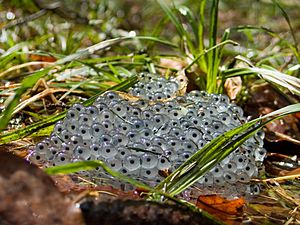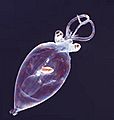Spawn (biology) facts for kids
Have you ever seen tiny, jelly-like blobs floating in water or stuck to plants? These are often spawn, which are the eggs of many water animals. When these animals lay their eggs, it's called spawning.
Fish, frogs, and other animals that live in water reproduce by spawning. After the eggs hatch, the baby fish are called fry. Young amphibians, like frogs, hatch into tadpoles.
Contents
What is Spawn?
Spawn refers to the eggs of aquatic animals. It's how many creatures that live in water, like fish, amphibians (frogs, salamanders), and even some molluscs (like squid), start their lives. These eggs are usually laid in large groups.
The act of laying these eggs is called spawning. It's a very important part of the reproduction process for these animals.
How Animals Spawn
Animals have many different ways to spawn. Most fish and amphibians release their eggs into the water. These eggs are then fertilized by the male.
Fish Spawning
Many fish lay their eggs on plants, rocks, or even the bottom of a river or lake. For example, pike fish often lay their eggs on plants that are flooded by high water. The eggs stick to the plant stems.
Some fish, like clownfish, lay their eggs in a safe spot, like near a sea anemone. The male clownfish then guards the eggs until they hatch. Other fish, like Siamese fighting fish, build special bubble nests on the water's surface to protect their eggs and young fry.
Amphibian Spawning
Amphibians, like frogs, usually lay their spawn in still or slow-moving water. Frog spawn often looks like a big jelly mass with many small black dots inside, which are the developing eggs. These eggs are usually attached to underwater plants or debris.
The Life Cycle After Spawning
Once the eggs are laid, they begin to develop. The time it takes for eggs to hatch can vary a lot, from a few days to several weeks.
From Egg to Young Animal
When fish eggs hatch, the tiny babies are called fry. They are very small and often look like miniature versions of their parents. For amphibians, the eggs hatch into tadpole]]s. Tadpoles live in water and breathe with gills, much like fish. They slowly change, growing legs and losing their tails, until they become adult frogs or salamanders.
Parental Care
Some animals, like the seahorse, have unique ways of caring for their young. Male seahorses carry the eggs in a special pouch until they are ready to hatch. Other fish, like some damselfish, keep their spawn safe inside things like empty snail shells.
Not all animals provide care. Some, like Pacific salmon, lay their eggs and then die shortly after. This is called "big bang" spawning.
Images for kids
-
The spawn (eggs) of a clownfish. The black spots are the developing eyes.
-
Pacific salmon are semelparous or "big bang" spawners, which means they die shortly after spawning
-
Pike usually spawn on vegetation flooded by high water. Their eggs adhere to the stems of plants.
-
Damselfish are substrate spawners. This one keeps her spawn in a gastropod shell
-
The stickleback glues plant material to make its nest
-
Male seahorses are pouch brooders
-
Guppies are livebearers. This one has been pregnant for about 26 days.
-
Within two or three days, the vulnerable goldfish eggs hatch into larvae, and rapidly develop into fry
-
Common frogs sorting out their spawn
-
Green turtle hatchling
-
Harvesting oyster mushroom Pleurotus ostreatus cultivated using spawns embedded in sawdust mixture placed in plastic containers
-
Baby paradise fish just hatched, gathered under the surface of a bubble nest
-
Anemone fish nest in an anemone. Here a male is protecting spawn produced by his partner.
-
Siamese fighting fish build bubble nests of varying sizes.
-
Spawning brittle star
-
Spawning sockeye salmon
-
In the middle of this weir is a fish ladder, which allows trout and salmon to pass the weir to go upriver to spawn.






























